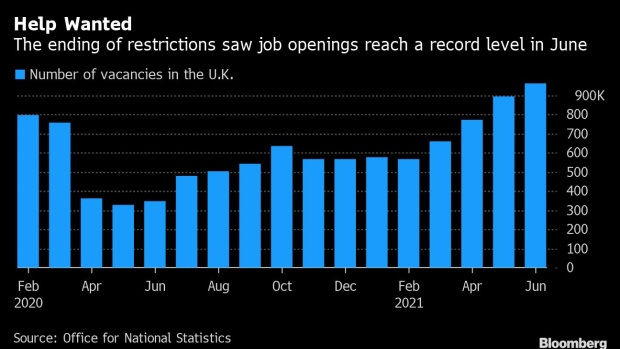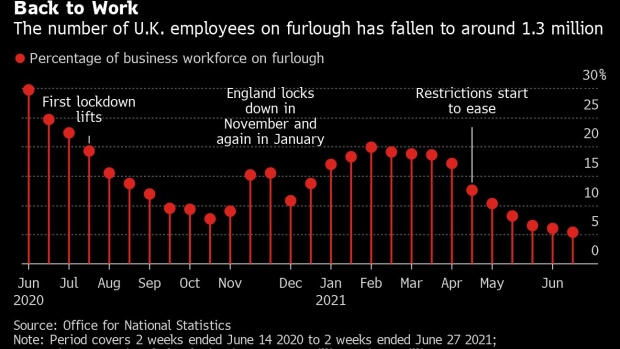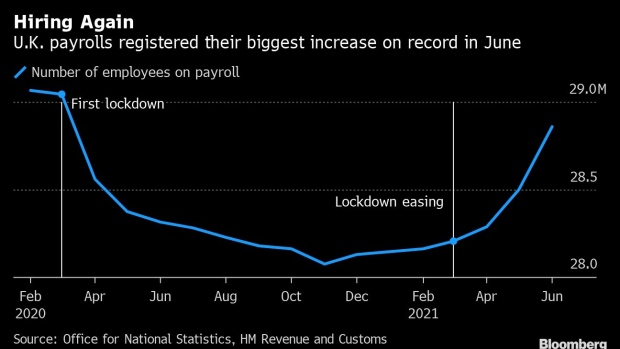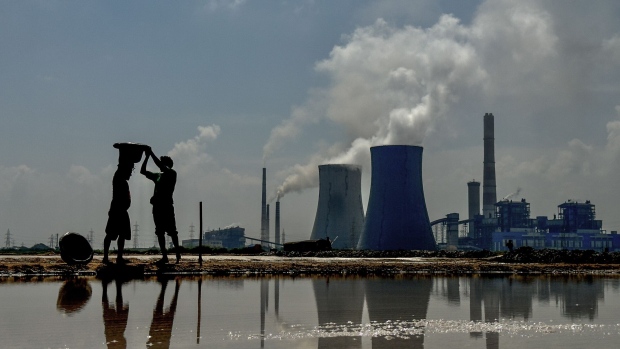Economy
UK companies hire at record pace as economy reopens – BNN
U.K. companies added payrolls at a record pace in June as the reopening of the economy triggered an unprecedented scramble for staff.
The number of employees on company books climbed by 356,000, the Office for National Statistics said Thursday. Demand for staff rose, with vacancies in June alone increasing to a record 962,000, up seven per cent from May.


“The rise in vacancies confirms the ongoing struggle to hire staff,” said Suren Thiru, head of economics at the British Chambers of Commerce. “The recruitment difficulties faced by firms go well beyond temporary bottlenecks. Staff shortages may drag on any recovery.”
The figures come a day after Bank of England Deputy Governor Dave Ramsden highlighted the unexpected buoyancy of the labor market and signaled that officials may soon have to consider whether to withdraw emergency stimulus to keep inflationary pressures in check.
Wages including bonuses rose an annual 7.3 per cent in the three months through May, the fastest on record. Statisticians cautioned that the figures are being distorted by the pandemic.
The increase reflected depressed wages a year earlier, the loss of low-paid jobs and the return to full-time work of staff who were previously furloughed on just 80% of their pre-pandemic salary. The ONS estimates underlying pay growth is running at 3.9 per cent to 5.1 per cent, and at between 3.2 per cent and 4.4 per cent when bonus payments are excluded.
”Do we think that is going to lead to sustained wage pressures? At the moment the answer would be ‘no,’” said Sanjay Raja, senior economist at Deutsche Bank. “I think we’ll see a string of very strong near-term wage growth, but we do think that will subside as we move into 2022. By the end of the next year, official wage data should come back down to reality. I don’t think we should lose sight of the fact that there’s still plenty of slack in the labor market.”


For the Bank of England, the key question is what happens when wage subsidies for furloughed workers end on Sept. 30. While the number of people receiving the benefit has fallen sharply — new ONS estimates Thursday put the figure as low as 1.1 million — many of them are likely to find themselves out of work come the autumn. Economists expect the jobless rate to reach 5.2 per cent by the end of the year.
Another risk facing the economy is that removing most of the remaining restrictions on July 19 may trigger a spike in coronavirus infections, making consumers more cautious about going out and spending.


The number of vacancies increased to 862,000 in the second quarter, above the pre-pandemic level for the first time. Demand for staff increased across most sectors of the economy last month.
Chancellor of the Exchequer Rishi Sunak hailed the latest labor market data as evidence that the economy is “bouncing back.”
British retailers contacted by Bloomberg say although there are clear issues with recruiting warehouse workers and delivery truck drivers currently, the much bigger challenge is staff, or sometimes whole teams, being forced to self-isolate when contacted by the National Health Service track and trace system.
The impact “will only get worse right across the economy, as cases are already rising fast and the final restrictions are eased,” said Helen Dickinson, chief executive of the British Retail Consortium.
Mike Cherry, national chairman of the Federation of Small Businesses, said labor recruitment issues in the fields of agriculture, tourism and hospitality mean many small firms are struggling to reopen fully despite being able to do so for the first time in more than a year.


The total number of people in work rose by 25,000 in the three month through May, much lower than the pace of previous periods. Inactivity — those neither in work nor looking for job — rose by 71,000. That resulted in a 68,000 drop in the unemployment level.
The jobless rate, which has been held down by the government’s furlough program, rose to 4.8% in the three months through May — only marginally above where it was before the pandemic struck
Economy
Israeli economy has proven to thrive despite crisis: Expert – Yahoo Canada Finance
Over the weekend, Iran launched a direct attack on Israel. Although Israel successfully intercepted the drones and missiles, the potential for an Israeli retaliation remains uncertain. David Blumberg of Blumberg Capital joins Yahoo Finance to discuss the state of the Israeli economy in light of these developments.
Blumberg claims that Israelis are “somewhat used to these types of things.” Blumberg notes that over the past 25 years, the country has weathered numerous crises, but has achieved consistent growth. He points to Israel’s GDP per capita of $54,000, which exceeds that of some of the world’s largest economies, as evidence of the economy’s ability to “thrive despite and through downturns.”
For more expert insight and the latest market action, click here to watch this full episode of Market Domination Overtime.
This post was written by Angel Smith
Video Transcript
JOSH LIPTON: Over the weekend, Iran launched its first ever direct attack on Israel with a salvo of hundreds of drones and missiles. David Blumberg is currently in Israel where his venture capital firm Blumberg Capital has offices and investments. David joins us now for more on the state of the Israeli economy and tech community. David, it is great to see you and have you on the show.
ADVERTISEMENT
DAVID BLUMBERG: Thank you so much, Josh. Great to see you as always.
JOSH LIPTON: So David, you’re in Israel now. You were obviously there over the weekend during this Iranian attack. So David, I just first want to know how you’re doing.
DAVID BLUMBERG: You can see I’m fine. I’m happy. I feel safe.
With my team here on the ground, we had a meeting with about 20 of our portfolio companies last night. We did it by Zoom instead in meeting. But people are very resilient here.
The streets, you can’t see them. They’re full of people at restaurants. The clubs are– the clubs are busy, traffic jams happening.
It’s remarkable how normal it is in a time when, I think, in America or other places, if this happened, people would be really freaking out. Israelis are unfortunately somewhat used to these kinds of things. This is the most severe it’s ever been. But they really did a great job with the Americans, the British, and the Jordanians, and French to knock down 99.9% of all the projectiles. So I think people feel like they won this battle.
JOSH LIPTON: And so David, the Israeli people a resilient community. At the same time, you know, David, they are engaged in this three-front war. It’s Iran. It’s Hamas to the south. It’s Hezbollah to the north.
It’s an enormous economic burden for the country, David. You just think of soldiers being called up and the tens of thousands of Israelis displaced in the north because of Hezbollah. How does the economy sustain this, David?
DAVID BLUMBERG: Well, I like to always look for history, Josh. So as we recall, over the last 25 years, there have been four or five war conflict situations plus COVID plus the dotcom crash plus a number of other financial crises, et cetera. So if we look at that, we see that over those 25 years, the Israeli GDP per capita measure of productivity of every individual working grew 2% to 3% faster than OECD countries during that same period pretty consistently.
Now, there were downturns and then they’ve come back. But over time, you see this growth. And in fact, I was looking at the data recently, in 2023, Israel achieved GDP per capita of $54,000. Now, that is higher than France, higher than the UK, and higher than Japan, which surprised me to see that growth. Because Israel, when I first started coming here, was a much poorer country.
But the tech boom in particular has really bolstered the economy. And as you’re asking, it seems to thrive despite and through downturns. There are downturns here, but the next year they get stronger.
Economy
Coal Keeps Powering India as Booming Economy Crushes Green Hopes – BNN Bloomberg


(Bloomberg) — Built along a stretch of salt flats in southern India, the Tuticorin power plant epitomizes a quagmire for the world’s fastest-growing major economy: how to provide reliable energy to 1.4 billion people.
For starters, the 1,050-megawatt coal plant, one of the region’s largest, was supposed to shut down. Opened four decades ago, the facility is too cramped to install retrofits to meet the government’s pollution norms, prompting India’s power ministry to plan its closure by 2022. Yet the facility continues to run at full blast, clocking 90% utilization in February. Aging boilers guzzle coal from mines nearly 2,000 kilometers away — a transport distance that only adds to the nation’s emissions footprint.
Electricity consumption in India is growing at the fastest rate of any major economy, driven by rising temperatures and incomes, which have pushed up sales of power-intensive appliances like air conditioners. That explosive equation has exposed the country’s teetering grid. Though Prime Minister Narendra Modi has promised to rapidly build out solar and wind generation to replace polluting fossil fuels, his administration hasn’t been able to keep up with demand, giving a second life to old, inefficient coal plants like the one in Tuticorin.
In recent months, Modi has green-lit a fresh wave of power station development and extended the lifespan of many existing coal assets. It’s a decision that puts India at odds with global allies who’re shunning the fuel on climate grounds, threatening Modi’s ambitions to curb air pollution and reduce the world’s third-largest share of greenhouse gas emissions.
Those dynamics will also hand the nation a crucial role in dictating the speed of the world’s retreat from coal. Demand in China, currently the top consumer, probably peaked last year and the rate of future growth will increasingly be driven by India and Southeast Asia’s rising economies, according to the International Energy Agency.
“The message is clear to both the international and domestic audiences: We’re all in for climate actions, but India’s domestic interests will take priority,” said Ashwini K. Swain, a fellow at Sustainable Futures Collaborative, a climate think tank in New Delhi.
India’s power ministry and Tamil Nadu Generation and Distribution Corp., which runs the Tuticorin coal plant, didn’t respond to requests for comment.
India has a long way to go to ensure reliable and affordable electricity. In Oct. 2021, the country was hit by a massive coal and power crisis, just as the economy began to emerge from the Covid-19 pandemic. Years of weak demand had led to sluggish growth in mining, transportation and power generation capacities.
Soon after the situation improved, officials realized the crisis wasn’t a blip. Energy demand rose to a new high the following summer, causing the worst supply shortages in eight years. In 2023, even though that squeeze eased at the national level, Maharashtra, one of India’s most industrialized states and home to its financial capital Mumbai, faced an alarming 10% peak deficit in August.
While shortages raised expectations that the country would accelerate the shift to green energy, India’s response was exactly the opposite. Officials pushed for more mining, abandoned plans to retire old power plants, raised targets to add coal-fired electricity and successfully lobbied international forums to adopt resolutions that wouldn’t hinder fossil fuel use.
“As a country, we should play to our strength, and coal is our strength,” said Prakash Tiwari, a former operations director at state-run NTPC Ltd., the nation’s largest power producer.
Alternative energy solutions haven’t yet caught on for financial, political and safety reasons.
More than 35 miles from Tuticorin, a dusty road leads to two solar power plants surrounded by sprawling wind parks. Ayana Renewable Power, which runs one of the facilities, sees a future in renewable power with energy storage to serve industrial users. That trend is rising in India, although far from becoming a source of mass power supplies. Solar accounted for 6% of generation in 2023, according to Bloomberg calculations based on power ministry data.
State-run power producer NLC India Ltd., which runs the other plant, is committing more than twice as much money to expanding mining, coal and lignite-fired power capacity than to building renewables, according to Chairman M. Prasanna Kumar.
Natural gas, pushed by producers as a less-polluting alternative to coal, has also struggled to compete. Nearly 25 gigawatts of gas-fired power capacity has been idling for years, priced out by other power sources, including coal. India doesn’t have enough domestically produced subsidized fuel to run the plants and operating these assets on imported liquefied natural gas is often too costly in India’s price-competitive electricity market.
Building hydropower dams is also fraught. Most of India’s potential there is locked in the fragile Himalayan region, where frequent extreme weather events, such as flash floods, jeopardize projects. The risks have galvanized local opposition against large dams, delaying plans by years and adding to costs that have rendered many of them unpalatable.
Nuclear power has seen a revival in many parts of the world for its low-emissions energy. But there, too, the industry in India has moved too slowly to make a mark and questions about safety persist. The nation’s nuclear liability law holds vendors and suppliers responsible for accidents. Many are still haunted by the Bhopal gas tragedy of 1984, which killed thousands of people exposed to toxic chemicals.
Consider Kudankulam, about 90 miles south of Tuticorin. The site hosts two reactors of 1 gigawatt each and four more are being added. In the nearby village of Idinthakarai, 52-year-old Mildred, who goes by one name, has been at the forefront of protesting the plant’s construction. She’s traveled across the country to discuss the risks of nuclear energy.
“Why can’t these be our main source of energy?” the activist asked on a recent day, pointing to a few rotating wind turbines near her home.
In 2008, India struck an agreement with the US to share nuclear technology and fuel, clearing the runway for new projects. India has also signed deals with foreign reactor suppliers, including General Electric-Hitachi, Westinghouse Electric Corp. and Areva SA, which later transfered the project to state-run peer Electricite de France SA. GE-Hitachi has since backed out, citing the liability law.
In the western state of Maharashtra, India had planned to build the world’s largest nuclear power plant, a mammoth 9.6 gigawatts facility near sprawling Alphonso mango orchards.
But locals resisted selling their land when Kiran Dixit, then an executive director of the state monopoly Nuclear Power Corp. of India Ltd., visited the area.
They thought prices were too low and worried that the plan would harm the livelihood of fishermen and the mango trees. The company tried to put those fears to rest and the land was eventually acquired, Dixit said. Still, the Jaitapur project has yet to significantly break ground as the two sides continue to discuss terms of the deal.
©2024 Bloomberg L.P.
Economy
Global Economy Soft Landing Masks Growing Debt, Inequality
|
|


The increasingly hopeful economic story of 2024 so far is that of a world headed for a soft landing. Unfortunately that same world is also becoming more dangerous, divided, indebted and unequal.
The reasons for short-term optimism are plain. A resilient US economy has defied expectations that the Federal Reserve’s barrage of interest-rate hikes would induce a recession. The UK—which dipped into a downturn at the end of last year—is already growing again, and Germany’s industrial sector is showing signs of a turnaround. Even in debt-hobbled China, domestic tourists spent more per trip over the Lunar New Year holiday than in 2019 for the first time since the pandemic, and the nation’s factories are humming a little more loudly.





-
Media13 hours ago
DJT Stock Plunges After Trump Media Files to Issue Shares
-
Business12 hours ago
FFAW, ASP Pleased With Resumption of Crab Fishery – VOCM
-
Media12 hours ago
Marjorie Taylor Greene won’t say what happened to her Trump Media stock
-



 Tech20 hours ago
Tech20 hours agoHow funny? Australian researchers use AI to generate cartoon captions – Digital Journal
-
Business13 hours ago
Javier Blas 10 Things Oil Traders Need to Know About Iran's Attack on Israel – OilPrice.com
-
Media11 hours ago
Trump Media stock slides again to bring it nearly 60% below its peak as euphoria fades – National Post
-
News23 hours ago
Anyone want a camper? It's a buyer's market for RVs as pandemic-era sales fizzle – CBC.ca
-



 Sports23 hours ago
Sports23 hours agoSerdachny scores overtime winner as Canada edges U.S. for women's hockey worlds gold – CBC Sports






